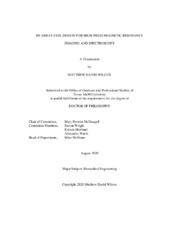| dc.description.abstract | Use of RF array coils for signal reception in magnetic resonance experiments is now commonplace due to their superior achievable SNR compared to conventional coils and their ability to dramatically reduce scan times through parallel imaging. When used as transmitters, arrays provide the additional benefit of enabling B₁ shimming, which becomes increasingly important as magnetic field strength is increased. Despite these obvious advantages, full adoption of array coil technology is still impeded by a number of challenges, particularly for non-¹H studies where appropriate system hardware is often unavailable. Due to the linear sensitivity increase with increasing magnetic field strength, use of high-field scanners also offers potential SNR benefits, but this too is hampered by technical difficulties – especially in achieving homogenous transmit fields at these field strengths. Assuming the challenges associated with high-field strengths and array coils can be overcome, a combination approach taking advantage of the benefits of both is an effective method to enable studies of low-sensitivity nuclei or further expand the capabilities of ¹H studies.
This work presents a number of projects intended to further extend the limits of array coil technology and address their associated challenges, specifically for high fields. First presented is a 16-channel array designed for 7 T MR breast spectroscopy studies of ¹³C, a particularly challenging target nucleus. The use of the close-fitting array for signal reception, combined with the 7 T field strength, maximizes the achievable signal-to-noise ratio to enable useful studies of natural-abundance ¹³C. Analysis of a novel space-saving solution for multinuclear array coil cable traps which is particularly attractive for high-field coils is next presented. Design guidelines are presented to properly tailor performance while minimizing size. Finally, an 8-channel ¹H transmit array and 24-channel receive array system used to validate a low-cost, add-on B₁ shimming system is demonstrated. The system combines dipole transmit elements with loop receive elements to allow high-sensitivity B₁ shimming experiments on a 7 T research scanner. As a whole, these projects present a step forward in array coil adoption for high-field applications. | en |


